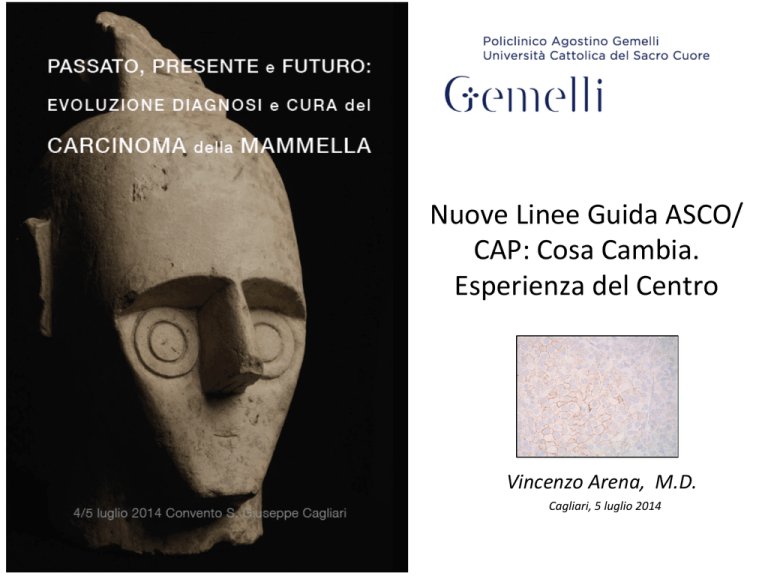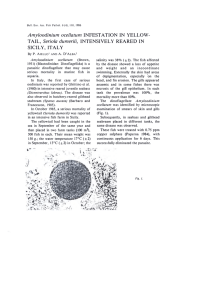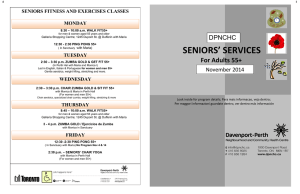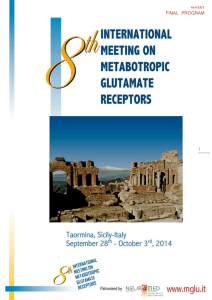Nuove Linee Guida ASCO/ CAP: Cosa Cambia. Esperienza del Centro
advertisement

Nuove Linee Guida ASCO/ CAP: Cosa Cambia. Esperienza del Centro Vincenzo Arena, M.D. Cagliari, 5 luglio 2014 SeC. 2013 To: Vincenzo Arena <vincenzo.arena@rm.unicaC.it> From: ken.kornfield@asco.org Subject: JCO/2013/520833 -­‐ Final Decision MS TITLE: HER2 Immunohistochemical Assessment: Is It Time To Refine The Scoring Criteria For The "2+" Category? -­‐ PLEASE DO NOT REPLY TO THIS EMAIL -­‐ Dear Dr. Arena: Thank you for your submission to Journal of Clinical Oncology. I have read your manuscript in full detail and JCO regrets to report that it is unable to accept your manuscript for publica2on. Many considera^ons factored into our decision. the appropriateness of your ar^cle for the broad readership of JCO in the absence of clinical outcomes (such as disease outcome), and our overall feeling that your paper would be more appropriate for a subspecialty pathology journal. Sincerely, We had concern regarding […] Antonio Wolff, MD Associate Editor Journal of Clinical Oncology 14.11.2013 Clinical outcome THE ALGORITHM Neoplasia IHC 0 1+ 3+ 2+ ISH Indeterminato – + Eq Trastuzumab No staining weak incomplete weak complete ≤ 10% weak complete at least 10% 0 1+ 1+ 2+ 3+ intense complete >30% 0 No staining 0 faint ≤ 10% 1+ faint incomplete > 10% 2+ weak/moderate e/o incomplete >10% 2+ Complete, intense and circumferen^al ≤ 10% 3+ Intense, complete, omogeneus,dark circumferen^al ≥10% Quale è la percentuale aCesa di casi nega^vi (sec. LG 2007) c h e p a s s e r a n n o n e l l a categoria “equivoca” (LG 2013)? LG 2007 13% di 0 LG 2013 52% di 0 16% 0 No Staining No Staining faint ≤ 10% Membrane staining <10% No staining Weak Incomplete 1+ Weak complete ≤10% 2+ Weak complete at least 10% Faint incomplete >10% Weak/ moderate e/o incomplete >10% Complete intense and circumferen^al ≤ 10% Faint/Barely percep^ble staining>10% (part of their membrane) Weak to moderate complete in >10% Intense complete >30% Intense, complete, omogeneus,dark circumferen^al ≥10% Strong complete in >10% ASCO/CAP 2007 ASCO/CAP 2013 FDA 3+ …sulla base del nuovo algoritmo… ↑ Casi 0 Casi 0 ↔ ↓ Casi 1+ Casi 1+ ↔↓ ↓ ↓ Casi 2+ Casi 2+ ↓ Casi 3+ Casi 3+ ↔ ↓ ↓ …Esperienza del centro… PRE ASCO/CAP 2013 Post ASCO/CAP 2013 Novembre 2012-­‐Maggio 2013 8 mesi Novembre 2013-­‐Maggio 2014 8 mesi 562 Determinazioni 592 Determinazioni 1154 Determinazioni di HER2 su K mammella invasivo …Esperienza del centro… “soDoEpi immunoistochimici” 300 266 250 233 216 212 200 Nov 2012-­‐Mag 2013 150 Nov 2013-­‐Mag 2014 100 49 50 35 41 37 41 24 0 Lum-­‐A Lum-­‐B Lum-­‐B H+ H+ TN …Esperienza del centro… Score di HER2 350 324 + 48 casi 302 300 250 200 Nov 2012-­‐Mag 2013 Nov 2013-­‐Mag 2014 150 134 121 112 100 64 53 44 50 0 0 1+ 2+ 3+ C …Esperienza del centro… 70,00% 60,00% 0 1+ 2+ 3+ N° casi Mar/Apr 2011 58,50% 20,40% 12% 9,20% 168 SeC/OC 2011 59,70% 17,90% 7,50% 14,90% 142 Mar/Apr 2012 63,30% 13,30% 17,20% 6,30% 128 SeC/OC 2012 50,90% 23,70% 16,70% 8,80% 114 Nov 2012/Mag 2013 57% 21% 11% 9,40% 562 Nov 2013/Mag 2014 51% 22% 18% 7,40% 592 0 1+ 2+ 3+ 50,00% Mar/Apr 2011 SeC/OC 2011 40,00% Mar/Apr 2012 SeC/OC 2012 30,00% Nov 2012/Mag 2013 Nov 2013/Mag 2014 20,00% 10,00% 0,00% 0 1+ 2+ 3+ C …Esperienza del centro… Distribuzione score 2 + 90 80 80 70 60 50 Nov 2012/ Mag 2013 38 40 Nov 2013/ Mag 2014 30 23 20 19 10 5 7 2 2 0 Lum-­‐A Lum-­‐B H+ TN C …Esperienza del centro… …E GLI ALTRI SCORES? 171 180 160 SCORE 0 80 152 70 138 140 72 62 60 120 105 54 54 50 100 80 40 60 30 34 40 SCORE 1 26 20 20 0 Lum-­‐A Lum-­‐B 0 TN Lum-­‐A SCORE 3 35 Lum-­‐B 32 30 25 21 8 5 10 22 22 20 15 10 5 0 Lum-­‐B H+ Nov 2012-­‐Mag 2013 H+ Nov 2013-­‐Mag 2014 TN THE ALGORITHM Neoplasia IHC 0 1+ 3+ 2+ ISH Indeterminato – + Eq Trastuzumab Single Probe Dual Probe Ra^o <1.8 HER<4 HER<4 Ra^o <2 HER<4 Ra^o 1.8/2.2 HER 4-­‐6 HER2 ≥ 4 <6 Ra^o < 2 HER2 ≥ 4<6 Ra^o <2 HER≤4 Non Amplificato Equivoco Ra^o≥2 HER ≥4 Ra^o >2.2 HER>6 ASCO/CAP 2007 HER>6 HER= 6 Ra^o≥2 HER <4 Ra^o ≥2 Her>4 Ra^o<2 HER >6 ASCO/CAP 2013 FDA Amplificato “Doppi equivoci” “Table 3 also shows that, CASI DOPPI EQUIVOCI “TEORICI” depending on w5hether à -­‐10% a single-­‐ or dual-­‐probe assay is used, 5% to 10% of the new IHC 2+ tumors would yield an equivocal FISH result, implying an increase in double-­‐ CASI Eequivocal SAMINATI = 126 results.” Correspondence CASI 2+ = 20 Table 3. Comparison of IHC Scores and FISH Results According to the 2013 Guideline Update FISH Result Single Probe Dual Probe IHC 2013 Total Negative Equivocal Positive Negative Equivocal Positive Score 0 Score 1! Score 2! Total 64 39 20 123 63 37 18 118 1 1 2 4 0 1 0 1 63 36 18 117 1 1 1 3 0 2 1 3 Abbreviations: FISH, fluorescent in situ hybridization; IHC, immunohistochemistry. Single probe Her2 Copy number = 5 Dual Probe RaEo = 5/1à 5 RaEo = 5/2à 2.5 …Esperienza del centro… A fronte dell’incremento dei casi e^cheCa^ come “2+” in immunoistochimica, quan^ sono risulta^ amplifica^ e quan^ non amplifica^? C …Esperienza del centro… …GUARDIAMO I 2+ Nov 2012-­‐Mag 2013 Nov 2013-­‐Mag 2014 29 19 PRE ASCO/CAP 2013 Post ASCO/CAP 2013 C …Esperienza del centro… …La posi^vità globale rela^va ai casi HER2+ ….. (2+A)+ (3+)= 20,00% 18,00% 18,50% 17,50% 12.4% NOV 2012-­‐MAG 2013 12.3% NOV 2013-­‐MAG 2014 17,20% 16,00% …Nel tempo… 14,00% 12,00% 10,50% 10,00% 8,00% 6,00% 4,00% 2,00% 0,00% Mar/Apr 2011 SeC/OC 2011 Mar/Apr 2012 SeC/OC 2012 Nov 2012/Mag Nov 2013/Mag 2013 2014 C …Esperienza del centro… …La posi^vità globale rela^va ai casi HER2+ ….. (2+A)+ (3+)= 12.4% NOV 2012-­‐MAG 2013 12.3% NOV 2013-­‐MAG 2014 …Se non avessi usato le nuove linee guida ASCO/CAP….??? 12.4% NOV 2 NOV2012-­‐MAG2013 (2+A)+ (3+)= 10.8% NOV 2013-­‐MAG2014 rces are strained, receptor status, p53 expression and tumour grade, o minimise the among others.8 It is well known that low-grade Downloaded from jcp.bmj.com on April 24, 2014 - Published by group.bmj.com re. Our study tumours are more likely to be oestrogen receptor le ical (ER)/progesterone receptor (PR) positive and need for further HER-2 negative, while half of high-grade tumours 7 Positive HER-2/neu ER/PR receptor HER-2 positive. Changingarefrequency of equivocal scores expression is more likely to coincide with absence and factors predictive of negative HER 2/neu of HER-2 overexpression, and the opposite relation 8–10 fluorescent in assitu invasive holds well.hybridisation The study by in Taucher et al9 goes th factor recep- as far saying that “the assessment of HER-2/neu carcinomas ofasthe breast the standard of status in this (ER/PR positive) subgroup of patients 1 Fouad Boulos,1may Chantal Farra,1 Ehabunnecessary”. M Saad Aldin,2,3 Cleo Masaad, breast cancer be G considered Different studies 2 1,4 2 Yasmin Hassoun, Fedda, Hassanand Doumiati, Ayman Nstatus Tawil,1 to and therapeutic haveFaysal linked ethnicity menopausal 2 5 2 Zeina Nasser, Zeina Nahleh, Arafat Tfayli y and erican cal ersity ated y, r ock, , USA ersity 13 13 013 Boulos F, et al. J Clin Pathol 2014;67:204–209. doi:10.1136/jclinpath-2013-201546 ABSTRACT Background Analysis of human epidermal growth factor receptor 2 (HER-2) status has become standard of care in breast cancer patients due to its important prognostic and therapeutic implications. Immunohistochemistry (IHC) is the most commonly used primary method for detection of HER-2 overexpression. Controversy exists on the interpretation of samples that are equivocal for HER 2 status (IHC 2+). Recent guidelines state that samples equivocal for HER 2 status require validation with fluorescent in situ hybridisation (FISH). The use of FISH, however, despite higher accuracy comes at a higher cost that is not affordable to all patients. Methods This study is a retrospective study conducted at the American University of Beirut Medical Center, including women diagnosed with breast cancer with equivocal IHC scores presenting between 2009 and 2011. We attempted to correlate clinicopathological characteristics of patients diagnosed with breast cancer that can influence conclusions made on HER 2 status when analysing IHC equivocal samples in an effort to decrease the need for FISH testing. 113 patients in our records were included; charts were reviewed for different patient clinical characteristics and samples were analysed for pathological characteristics. Results Using logistic regression, progesterone receptor status and HER-2 staining of the normal glands around 113 cases “It is well known that low-­‐grade tumours are more likely to be oestrogen receptor(ER)/progesterone receptor (PR) posiEve and HER-­‐2 negaEve, while half of high-­‐grade tumours are HER-­‐2 posiEve.” implications. The most commonly used methods for the detection of HER-2 overexpression are immunohistochemistry (IHC) detecting protein overexpression and fluorescent in situ hybridisation (FISH) detecting gene amplification.1 There is still no consensus on a gold standard for determining HER-2 status with both methods posing advantages and disadvantages.2–5 IHC has the compelling advantages of affordability, ease of performance and wide availability in most pathology laboratories, although its accuracy and reproducibility may be affected by tissue handling and fixation, and antibody sensitivity and specificity.6 Alternatively, and while being more reliable and reproducible than IHC, FISH is more costly and necessitates advanced technical skill and experience.6 The 2007 American Society for Clinical Oncology/College of American Pathologists (ASCO/ CAP) guidelines proposed a testing algorithm (figure 1) that takes into account the above factors.3 Accordingly, IHC is sufficient for positive and negative HER-2 results, while equivocal (2+) results are settled by FISH testing. Interestingly, since the introduction of the FISH technique to our pathology department in 2009 to abide by this algorithm, it was noted that the rate of equivocal IHC results increased from 16% to 37%. A higher rate of FISH testing translated into a potentially unnecessary financial burden on the many Lebanese patients without health “PosiEve ER/PR receptor expression is more likely to coincide with absence of HER-­‐2 overexpression, and the opposite relaEon holds as well.” Taucher S, Rudas M, Mader RM, et al. patient clinical characteristics and samples were analysed for pathological characteristics. Results Using logistic regression, progesterone receptor status and HER-2 staining of the normal glands around the tumour by IHC were the two statistically significant variables that showed association with FISH results. The strength of progesterone receptor status positivity and HER-2 staining of the normal glands around the tumour were proportional to the likelihood of a negative FISH. Also, the presence of strong and diffuse hormone receptor positivity in low-grade tumours was predictive of negative HER-2 status. Conclusions In countries where resources are strained, oncologists need to think of measures to minimise the increasing financial burden of cancer care. Our study serves to highlight a few clinicopathological characteristics that might eliminate the need for further testing through FISH. the rate of equivocal IHC results increased from 16% to 37%. A higher rate of FISH testing transPredictors of negaKve HER2 FISH lated into a potentially unnecessary financial burden tesKng on the many Lebanese patients without health insurance. 1. “non tumour with 100% ER/PR+ or scores for mstate itosis othat r The ASCO/CAP with 2007low guidelines a tubule information formaKon was isHER2 careful review of patient important amplified following an IHC 7 score of to guide determination of HER-2 status as there 2+” have been several published results on the correlation between HER-2 byabsence both oFISH and 2. The cstatus omplete f normal IHC and the clinicopathological of gland staining wcharacteristics as associated with a high level of FISH posiKvity breast cancer. Such characteristics include hormone while tand he presence receptor status, p53 (67%), expression tumourof grade, land staining showed a among others.8 It isnormal well gknown that low-grade concomitant 20% FISH posiKvity. tumours are more likely to be oestrogen receptor (ER)/progesterone3. receptor (PR)are positive Younger woman more likely and to HER-2 negative, while half of high-grade tumours have aggressive HER2 amplified 7 neoplasm Positive ER/PR receptor are HER-2 positive. expression is more likely to coincide with absence of HER-2 overexpression, and the opposite relation holds as well.8–10 The study by Taucher et al9 goes as far as saying that “the assessment of HER-2/neu status in this (ER/PR positive) subgroup of patients may be considered unnecessary”. Different studies have linked ethnicity and menopausal status to “…But it should sEll be emphasized that in cases where neither coverage nor laboratory resources are an issue, it remains advisable to default to FISH tesEng in all cases with equivocal IHC results in order to give every paEent the best opportunity for well-­‐guided management” INTRODUCTION Analysis of human epidermal growth factor receptor 2 (HER-2) status has become the standard of care in patients presenting with breast cancer because of its important prognostic and therapeutic Boulos F, et al. J Clin Pathol 2014;67:204–209. doi:10.1136/jclinpath-2013-201546 …Esperienza del centro… Ci sono “amplifica^” ed “amplifica^” C …Esperienza del centro… PRE ASCO/CAP 2013 Nov-­‐2012/Mag 2013 16 15 14 12 10 8 6 4 4 2 0 need to count not need to count Nov 2012-­‐Mag 2013 PRE ASCO/CAP 2013 C …Esperienza del centro… Nel periodo Nov 2012-­‐Mag 2013 6 casi amplifica^ “inaCesi” Ki67 <20% ER/PR pos ER/PR pos ER/PR neg 3 CDI NOS G2 N0 1 CDI NOS G2 N0 mul^focale 1 CDI G2 (aspe~ apocrini) N+ (sn) 1 Apocrino G3 N0 Età media 56 aa (46-­‐70) PRE ASCO/CAP 2013 C …Esperienza del centro… C …Esperienza del centro… Post ASCO/CAP 2013 Nov-­‐2013/Mag 2014 18 16 16 14 13 12 10 8 6 4 2 0 need to count not need to count Nov 2013-­‐Mag 2014 C …Esperienza del centro… Nel periodo Nov 2013-­‐Mag 2014 ….Tra i 29 casi 2+ Amplifica^….. 9 casi erano “inaCesi” ER/PR Pos Ki67 <20% 2 CDI “gland-­‐forming” N0 1 CDI G2 N0 1 CDI mul^centrico 1 CDI G2 micropapillare 1 CDI G2 (recidiva) (primo nel 2009) 1 CLI pleomorfo ER/PR Neg Post ASCO/CAP 2013 1 CDI G2 N0 1 CDI G2 con aspe~ metaplas^ci N0 Età media 67 aa (48-­‐86) Post ASCO/CAP 2013 Post ASCO/CAP 2013 “ …note that there are some rare breast cancers (eg, gland forming tumors, micropapillary carcinomas) that show IHC 1+ staining that is intense but incomplete (basolateral or U shaped) and that are found to be amplified. [ASCO/CAP Guidelines 2013] C …Esperienza del centro… Ci sono “non amplifica^” e “ non amplifica^” C …Esperienza del centro… 50 44 45 40 35 30 25 20 15 10 5 1 0 need to count not need to count Nov 2012-­‐Mag 2013 56 60 50 40 30 28 1,85 1,65 1,725 1,8 1,843 20 10 0 need to count not need to count Nov 2013-­‐Mag2014 C …Esperienza del centro… 1,85 1,65 1,725 1,8 1,843 “No classifica^on is perfect nor is it likely that it will ever be. All classifica^ons depend on o u r k n o w l e d g e o f t h e pathology. Since this knowledge is far from perfect or complete, no classifica^on can be other than a reasonable compromise…” C …Esperienza del centro… Epitelio apocrino “normale” AR+/ER-­‐/PR-­‐ APOCRINI PURI APOCRINE-­‐LIKE 69% puri 57% HER+ 31% “Like” 47% HER+ 55 casi


